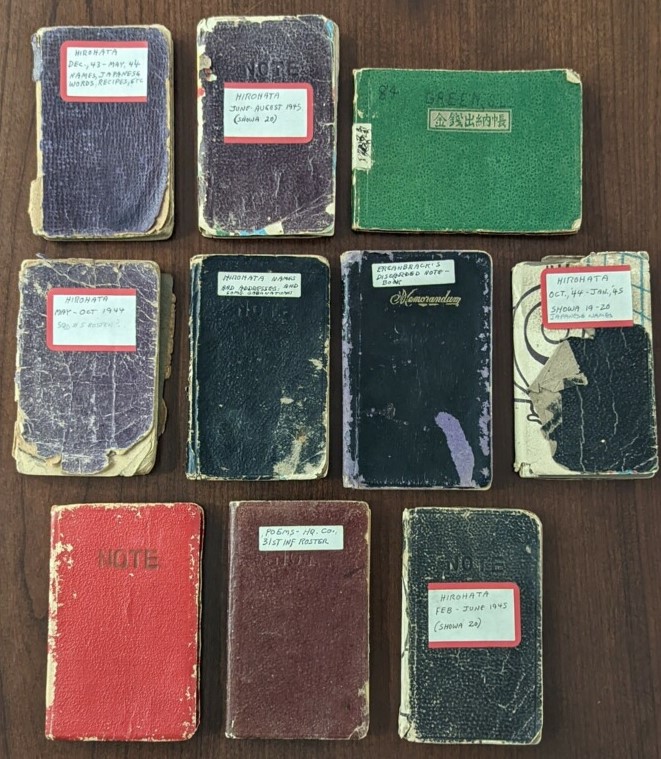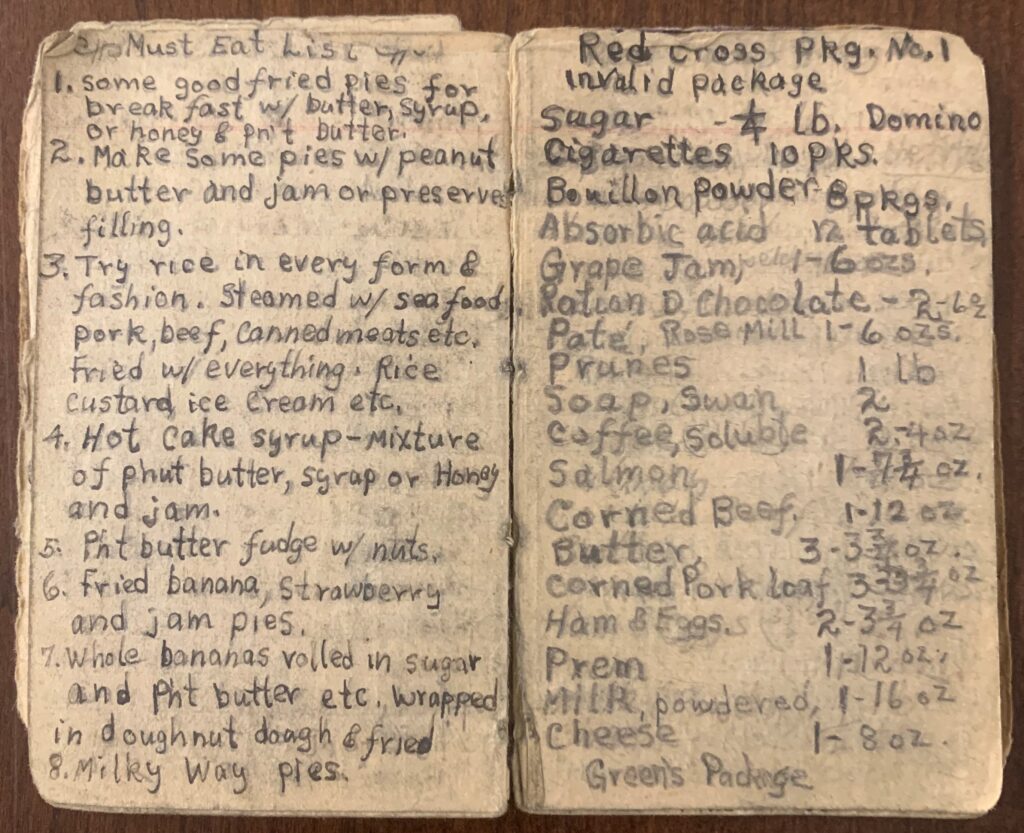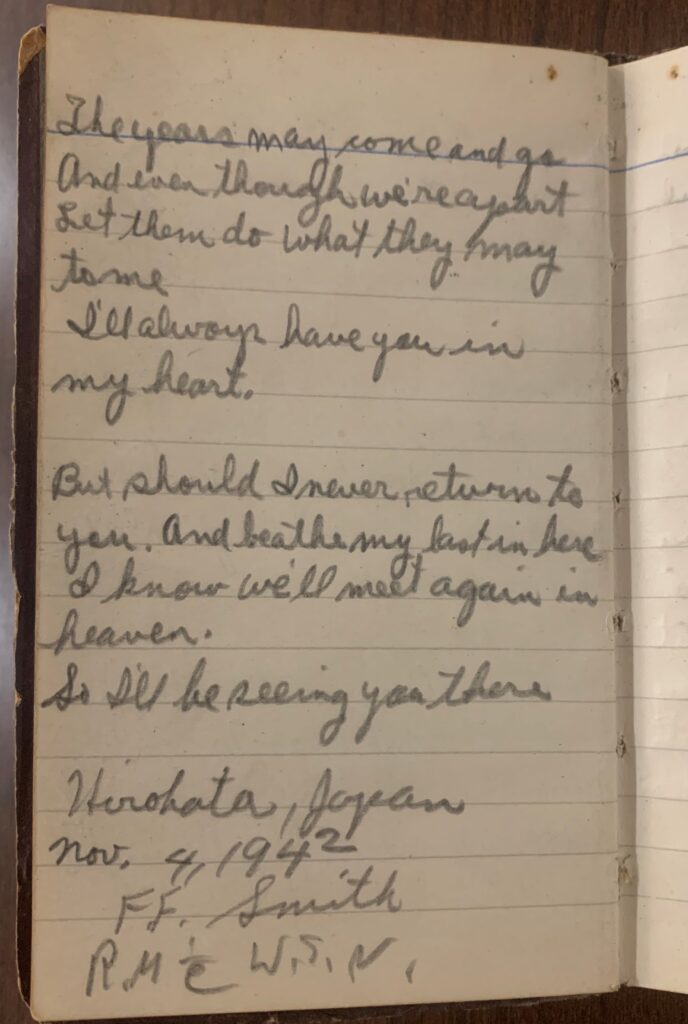Smith Green: The Horned Frog Hero
“These men suffered enough for a hundred lifetimes, and no one in this country should be allowed to forget it.”[1]

This collection of journals contains the everyday life of Smith during his time as a Prisoner of War in Moji, Japan.
Smith Green’s journey started with a plan to serve a two-year tour during World War II. He was a communications chief of the 31st Infantry Regiment of the United States Army. In a blink of an eye, that two-year tour turned into six years and eleven days away from home, as Green became a Prisoner of War in Moji, Japan.[2] Green found a way to persevere and return home to earn a Commerce degree from TCU.[3] Much more than a soldier, POW, Horned Frog or man, Smith Green is a hero.
Before Green was locked away in a POW camp, he was forced to survive the Bataan Death March. Like Green, a man named Peter Marshall also lived through the march and he wrote a book called 1368 Days. The book covers his 1368 days as a POW in Japan. Marshall also had his times of struggle, much like Smith, and wrote that he “began to wonder how many of us would be alive after the coming winter.”[4] The moment that both of these soldiers were captured, everything changed. They went from soldiers courageously fighting for their country, to prisoners fighting for their lives. They no longer focused on winning a war, they focused on staying alive for as long as possible.

Smith Green recorded notebooks dating from December of 1943 to August of 1945, telling the stories of the everyday life of a World War II POW. He wrote about everything under the sun as an attempt to pass the time while he was imprisoned by the Japanese (whom he referred to as “dog face”). He filled his appetite with the thoughts and lists of food dishes that he wrote down. He kept a list, taking up a few pages even, called the Must Eat List. This list included a variety of meals, including sukiyaki, “every kind of candy and pastry obtainable,” many different meats made in different styles, real Italian spaghetti, and even tacos.[5] He also created a tiny translator, by keeping a well-organized list of Japanese words that he was learning. While the first few journals only have a couple translations, the last couple of journals are filled with pages top to bottom with words and phrases he was learning while building a relationship with the guards.

On May 6, 1944, Green saw the impact of that relationship as he met with the “kaigun,” a guard who was giving the American prisoners too harsh a punishment.[6] “Kaigun” nearly translates to Navy in English, so Green met with someone important. Green was a hardworking man, and that hard work earned the respect of not only the Japanese Guards, but his fellow imprisoned soldiers as well. He was named the head leader, or “honcho” as he referred to it.[7] As the leader, Green used the journals to keep notes on each of the 57 other prisoners that were in Moji.
While it seems like Smith Green was in good spirits during his stay through learning Japanese and writing recipes, times were not always perfect. From grueling hours of extreme labor to long nights of no sleep and beatings, Smith Green endured it all. There was a span of time when Green kept a running tab of how much money he thought it would cost to buy his freedom. As the tally got higher, the more unsettled he was. At one point, he received a package on May 28, 1944, to which he wrote back, “Teach the kids to say, ‘Uncle Smith’ as I hope to be home soon.”[8]
Only a special person can survive war, let alone as a POW. Smith Green did it all as a triumphant leader and returned home to be a model of what it means to be a true Horned Frog. We all should try to be like Smith Green in our ways each day. We should live courageously, while looking out for others, all while never giving up on hope. Life for Green was not easy from the years 1943 to 1945, but he never gave up on not only himself, but his brothers around him as well. There is a saying that states that not all heroes wear capes, and I believe that Smith Green is a fantastic definition of being one of those heroes.
[1] Hampton Sides, Ghost Soldiers: The Epic Account of World War II’s Greatest Rescue Mission (Anchor Books, New York City, NY, 2002), 418.
[2] Smith Green, “Hirohato Journals,” 1943-1945, folder 6, Records of Edward McShane Waits, Special Collections, Mary Couts Burnett Library, Texas Christian University
[3] Texas Christian University Correspondence and Ephemera, 1958-1961, folder 26, Records of Edward McShane Waits, Special Collections, Mary Couts Burnett Library, Texas Christian University
[4] Peter B. Marshall, “1945” 1368 Days: An American POW in WWII Japan: A Memoir (Eugene, OR: Luminare Press, 2017), 79.
[5] Smith Green, “Hirohato Journals,” 1943-1945, folder 6, Records of Edward McShane Waits, Special Collections, Mary Couts Burnett Library, Texas Christian University.
[6]Smith Green, “Hirohato Journals,” 1943-1945, folder 6, Records of Edward McShane Waits, Special Collections, Mary Couts Burnett Library, Texas Christian University.
[7] Smith Green, “Hirohato Journals,” 1943-1945, folder 6, Records of Edward McShane Waits, Special Collections, Mary Couts Burnett Library, Texas Christian University.
[8] Smith Green, “Hirohato Journals,” 1943-1945, folder 6, Records of Edward McShane Waits, Special Collections, Mary Couts Burnett Library, Texas Christian University.
For Further Reading
Hopkinson, Deborah. Race Against Death: The Greatest POW Rescue of World War II (New York: Scholastic Focus, 2022).
Deborah Hopkinson uses her book, Race Against Death, to highlight the thrilling rescue of Prisoners of War from the Cabanatuan Camp as well as other camps. The book includes stories of true heroism as well as features of the “Angels of the Underground.”
Lawton, Manny. Some Survived: An Eyewitness Account of the Bataan Death March and the Men Who Lived through It (Chapel Hill, NC: Algonquin Books, 2004).
Lawton’s book allows for the reader to take a first-person perspective into the Bataan Death March, which provides a saddening yet thrilling reading experience. This book shines light on the many triumphs the men had during their times as Prisoners of War, rather than focusing on the many hardships they had to face.
Moore, Bealer W. The Unseen Hand: The Experience of a WWII POW and the Death March of 1945 (New York: Moodswinger’s Press, 2020).
Bealer Moore does a remarkable job in his book of giving the reader a perspective on both life as a Prisoner of War in World War II after he and his flight crew were struck down and captured. He too, was a prisoner that survived the horrifying Bataan Death March.